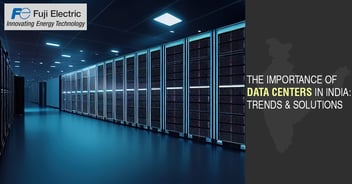Solar Inverters: Enabling Renewable Energy to Power the Future

Solar energy is gaining momentum worldwide as a sustainable and environmentally friendly alternative to conventional power sources. At the core of solar power systems are solar inverters, which, while presenting some challenges such as high initial installation costs and intermittency due to weather conditions, offer numerous benefits. Fuji Electric India is actively contributing to the growth of India's solar industry, aligning with the government's push towards renewable energy.
Challenges in Solar Inverter Adoption
Challenges in integrating solar pumps can be multifaceted. Firstly, the intermittent nature of solar power generation poses a considerable challenge. Solar energy production is contingent on weather conditions and the availability of sunlight. This intermittency can result in variations in power supply, which may disrupt the continuous operation of water pumping systems, particularly during cloudy days or nighttime.
Additionally, ensuring the proper design and installation of solar pumping systems requires technical expertise. Inexperienced users may face difficulties in setting up and maintaining the system effectively, potentially leading to operational issues.
Furthermore, the variability in water demand for different applications can be challenging to address. Matching the capacity of solar pumps with fluctuating water demand levels requires careful planning and system configuration.
To overcome these challenges, Fuji Electric offers efficient and customizable solar pump inverters equipped with advanced features. These inverters maximize energy utilization, adapt to changing conditions, and provide a high degree of flexibility, allowing users to overcome the challenges associated with solar pumping systems. Additionally, Fuji Electric's after-sales support ensures that users receive the necessary technical assistance to maintain and optimize their systems effectively.
Benefits of Solar Inverters and Solar Power
Despite these challenges, solar inverters and solar power systems offer substantial benefits. Solar energy is clean, renewable, and environmentally friendly, with a minimal carbon footprint and no greenhouse gas emissions. It's abundant and readily available, making it ideal for remote and off-grid areas. Solar power systems are also scalable, and customizable to meet diverse user and application needs.
The Significance of Solar Pumping
Solar pumping is a crucial application that leverages solar energy to provide clean and sustainable water pumping solutions. At the heart of this technology are solar pump inverters, which convert the direct current generated by solar panels into alternating current. Fuji Electric's solar pump inverters are highly versatile, accepting various input sources, including solar DC power supply (ranging from DC 200V-350V to DC 350V-750V) and single-phase or three-phase AC power supply (AC 220V, 380V, 400V, 460V, 480V). This adaptability makes them well-suited for remote and arid regions, where access to traditional power sources can be limited.
Solar Pumping VFD Features & Benefits
Solar pumping VFDs are engineered with advanced features that make them essential for harnessing solar energy in water pumping applications. One of their standout features is the Maximum Power Point Tracking (MPPT) function, which ensures efficient energy utilization by constantly optimizing the system's performance. This function allows the system to operate at its maximum capacity, making the most of the energy generated by solar panels.
Moreover, these VFDs offer a high degree of customization. Users have the flexibility to set start and stop criteria based on specific system conditions, time, frequency, or power levels. This adaptability ensures that the pumping system can be finely tuned to meet the unique requirements of various applications, enhancing efficiency and resource management.
In addition to their customization options, these VFDs include essential safety features. They can detect dry pump conditions, preventing damage to the pump and prolonging its lifespan. Furthermore, they offer a low-power function, which not only conserves energy but also contributes to the overall longevity of the system.
Another notable aspect is the wide range of motor compatibility. These VFDs can efficiently control both asynchronous motors and permanent magnet synchronous motors, making them versatile for different setups and scenarios. The VFDs also excel in condition monitoring. They can detect sudden changes in conditions, particularly variations in irradiance, allowing for responsive and adaptive operation. This capability is crucial for maintaining optimal system performance and efficiency.
Moreover, the VFDs feature dual sets of Proportional-Integral-Derivative (PID) gains. This enables precise and smooth operation, making them suitable for applications where maintaining a specific setpoint is critical. Additionally, they can be used for water tank level control, enhancing their usability in various situations.
For added convenience, these VFDs can be configured for grid connection, providing a seamless transition between solar power and grid power as needed. This feature is valuable for maintenance and as a backup system, ensuring the reliability of the pumping operation.
Solar Pumping for a Sustainable Future
Fuji Electric India's solar pumping solutions are not only environmentally friendly but also economically viable. By harnessing the power of the sun to provide clean water pumping solutions, these systems contribute to a sustainable future. As India aims to expand its solar energy capacity, Fuji Electric's commitment to innovation and advanced technology is helping to drive the growth of solar pumping adoption across the country. With reliable and efficient products, backed by exceptional after-sales support, Fuji Electric India empowers individuals and organizations to embrace renewable energy solutions and reduce their carbon footprint.
 China
China Europe
Europe France
France Hong Kong
Hong Kong Indonesia
Indonesia Japan
Japan Singapore
Singapore Thailand
Thailand USA
USA

